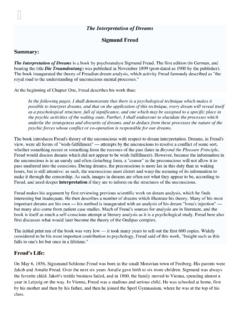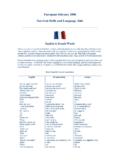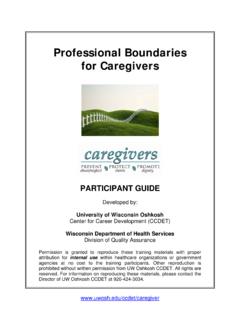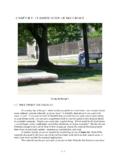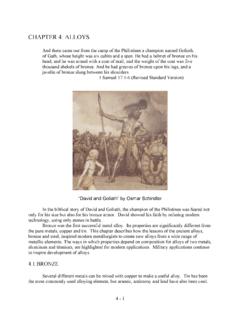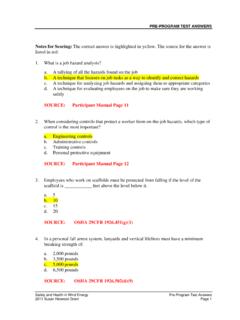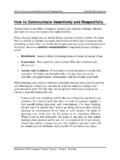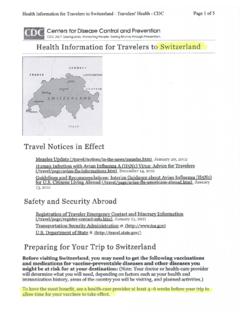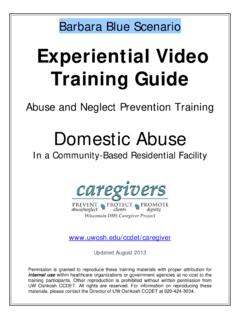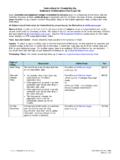Transcription of Fire Safety and Emergency Procedures
1 Fire Safety and Emergency Procedures FACILITATOR GUIDE Developed by: University of Wisconsin Oshkosh Center for Career Development (CCDET) Permission is granted to reproduce these training materials with proper attribution for internal use within healthcare organizations or government agencies at no cost to the training participants. Other reproduction is prohibited without written permission from UW Oshkosh CCDET. All rights are reserved. For information on reproducing these materials, please contact the Director of UW Oshkosh CCDET at 920-424-3034. Fire Safety Facilitator Guide UW Oshkosh CCDET 2 April 2013 Table of Contents Learning Points.
2 3 Introduction .. 3 What Causes Fire .. 4 Classifications of Fire .. 5 Activity: Identify Flammable Materials .. 6 Sources of Fire .. 7 Who is at Risk? .. 8 Fire Extinguishers .. 10 Activity: Locate the Equipment in Your Facility .. 11 Responding to an Emergency RACE(E) .. 12 Learning Points Review .. 13 Wrap-Up .. 13 Facilitator Preparation .. 14 Resources .. 14 NOTE: This is NOT the department-approved training on Fire Safety required under DHS for CBRFs. This training is designed for use by healthcare facilities for continuing education purposes for caregivers. Facilitators are not required to have prior approval to teach this training.
3 Instructions for facilitators are included throughout this guide bracketed, indented, and italicized. These instructions are not included in participant guides. Persons receiving healthcare services from providers regulated by the DHS Division of Quality Assurance may be referred to as residents, patients, clients, or customers. For consistency, this training uses the term resident to refer to persons receiving health care in a variety of settings. Fire Safety Facilitator Guide UW Oshkosh CCDET 3 April 2013 Learning Points These are the major goals for this training: Learn more about fire and flammable materials Identify special needs of those in your care during an Emergency Review the steps for discharging a fire extinguisher Understand the steps for responding to a fire Emergency Introduction There are many reasons why caregivers must be aware of fire Safety rules and Emergency Procedures .
4 Wisconsin laws and federal regulations often outline facility requirements for keeping residents safe in the event of a fire or other Emergency . Caregivers who provide care in a patient s own home should also be aware of fire hazards and safe Procedures . Fragile elders and people with developmental disabilities may be unable to adequately respond to emergencies independently. It is the job of the facility and the caregiver to help assure their Safety . What do you believe might be the major cause of fires in healthcare facilities? [Ask participants to offer responses. You may jot them down on a flip chart. The idea is to introduce participants to the topic and help them shift away from other thoughts, distractions.]
5 The main source of fires in healthcare facilities is kitchen/cooking-related. At one time, it was smoking/smoking materials. That has changed with the Wisconsin law (2010) banning smoking indoors in public facilities, including healthcare facilities.] Fire Safety Facilitator Guide UW Oshkosh CCDET 4 April 2013 What Causes Fire The fire triangle is made up of the three components needed to produce fire: Fuel (something that will burn) Heat (enough to make the fuel burn) Oxygen (air) All three components must be present to have a fire. Fire will burn until one or more of the components are removed. Traditional fire extinguishing methods involve removing the fuel, heat, or oxygen.
6 Once you have oxygen, fuel and heat, a fourth component, called the uninhibited chain reaction, is needed to maintain the fire. The chain reaction provides the heat necessary to maintain the fire. The addition of this component makes up what is called the fire tetrahedron (a four-sided figure). The term tetrahedron may be difficult to remember, but the key point is that for fire to occur, you need fuel, heat, oxygen and the chain reaction between the three of them. The only way to stop a fire is to eliminate one of those four elements in the following ways: 1. Cool the burning material 2. Exclude oxygen 3. Remove the fuel 4.
7 Break the chemical reaction - Reprinted with permission from the NFPA website , copyright 2009; National Fire Protection Association, Quincy, MA. All rights reserved. Fire Safety Facilitator Guide UW Oshkosh CCDET 5 April 2013 Classifications of Fire Classifications of fire are based on fuel type. They match up with classes of fire extinguishers, which will be covered later in the course. Class A fires involve ordinary combustible (burnable) materials, such as wood, cloth, paper, rubber and many plastics. They burn with an ember and leave an ash. Class A fires are extinguished by cooling the fuel to a temperature that is below the ignition temperature.
8 Water and other extinguishing agents are effective in putting out a Class A fire. They can also be extinguished using the dry chemicals used for Class A, B and C fires. Class B fires involve flammable liquids (which can burn at room temperature) and combustible liquids (which require heat to ignite). Examples of class B fuels include cooking oils, oil-based paints, solvents, lacquers, nail polish and aerosol hairspray. Class B fires are a high fire hazard; water may not extinguish the fire. This type of fire is best extinguished by creating a barrier between the fuel and the oxygen, or a smothering effect. Dry chemical, foam, vaporizing liquids, carbon dioxide and water fog can be used to extinguish a Class B fire, depending on the circumstances of the fire.
9 Class C fires are those that occur because of electrical equipment that has a current running through it, such as appliances, extension cords, outlets, and fuse boxes. Special techniques and agents are required to extinguish these types of fires, most commonly carbon dioxide or dry chemical agents. Use of foam, water and other water-type extinguishing agents is very dangerous because water conducts electricity. Use of these on an electrical or Class C fire could kill or injure the person operating the extinguisher or at the very least, cause severe damage to the electrical equipment. Fire Safety Facilitator Guide UW Oshkosh CCDET 6 April 2013 Class D fires involve combustible metals, such as magnesium, titanium, zirconium, sodium, lithium and potassium.
10 Most cars contain numerous such metals. Because of extremely high flame temperatures, water can break down into hydrogen and oxygen, enhancing burning or exploding. Class D fires should be extinguished with special powders based on sodium chloride or other salts; also clean dry sand. It is very unlikely that you would encounter a Class D fire in a health care facility. Class K fires are fires that involve vegetable oils, animal oils or fats in cooking appliances. This classification is for commercial kitchens. Some large facilities may have kitchens that are classified as commercial. -Reprinted with permission from the NFPA website , copyright 2009; National Fire Protection Association, Quincy, MA.
